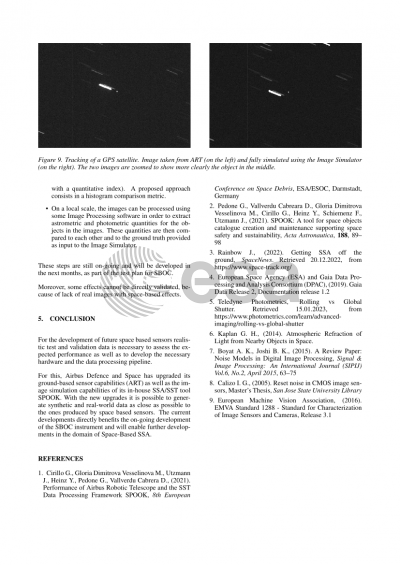Document details

Abstract
In June 2018 Airbus deployed Airbus Robotic Telescope (ART), a 40 cm aperture telescope equipped with a CCD detector and an UBVRI filter wheel, located in Extremadura, Spain. Since 2018, the telescope has been performing observations for internal validation, research and within the scope of several studies for national, European and international customers. Furthermore, it has been added into the list of observatories of the Minor Planet Center (MPC) of the International Astronomical Union (IAU). The data gathered so far has been used to validate ART in terms of astrometric accuracy for different observation scenarios.
ART operates in combination with the Special Perturbations Orbit determination and Orbit analysis toolKit (SPOOK), a versatile software framework developed at Airbus. SPOOK provides the complete set of tools necessary for an end-to-end SST cataloguing pipeline; these are observation plan generation using different strategies for different classes of objects, image processing to extract features of interest, tracklet linking of measurements, correlation with internal or external catalogues (e.g. Space-Track General Perturbation (GP) catalogue), Initial Orbit Determination (IOD), Orbit Determination (OD) and Light Curve processing capabilities.
In 2022 ART has received an upgrade with the installation of a camera with a large CMOS detector, enabling wide FOV, high sensitivity and high frame rates.
ART and SPOOK serve as test-bed for the development of space-based space surveillance sensors and allow the emulation of space-based observation scenarios and end-to-end tests using real-world images. For the ESA SBOC Phase B2 activity, this test pipeline is employed as an important element for validation of an image processing prototype. The space-based SBOC/VISDOMS mission aims at the detection of small objects with high relative angular velocity.
However, a ground-based sensor cannot catch all the effects that occur in space (e.g. cosmic rays hitting the detector, scene rotation due to a non-sidereal pointing, vibrations and pointing errors due to the AOCS system, detection of objects with angular velocity of several degrees per second).
For this reason an Image Simulator tool has been added inside SPOOK. This tool allows the generation of fully synthetic images, simulating the effects that occur for space observations performed from a space-based sensor. Moreover, it allows having a finer tuning on the generated scenarios (star background density, number and characteristics of the space objects crossing the FOV, etc.).
The paper will present the current status of ART, SPOOK, observation campaigns, achieved performances and its use for testing space-based space surveillance scenarios.
Preview










